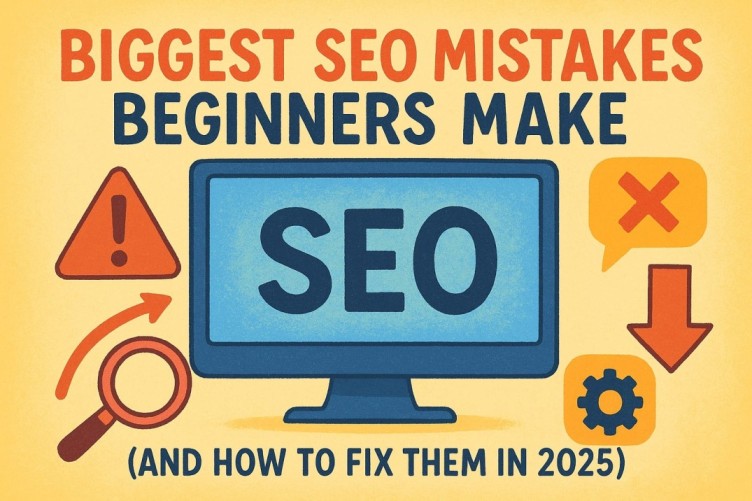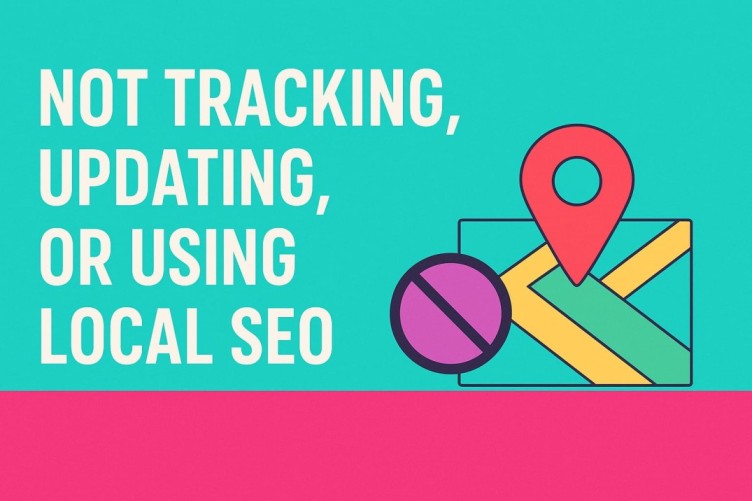Avoid the biggest SEO mistakes beginners make! Learn simple fixes, step-by-step tips, and a complete SEO checklist to boost Google rankings, attract traffic, and grow your website in 2025.

Search Engine Optimization (SEO) can feel overwhelming for beginners. You’ve probably heard terms like keywords, meta tags, backlinks, and content optimization—and wondered if it’s too complicated.
The truth? SEO works best when you get the basics right. Done properly, it drives traffic, builds credibility, and grows your business. Done wrong, your website stays invisible, like a shop with no signboard.
In this guide, we’ll break down the biggest SEO mistakes beginners make, explain why they happen, and show step-by-step fixes that are easy to follow—even if you’re new.
1. Skipping Keyword Research and Content Planning
Keywords are the questions people type into Google. If you don’t know what people are searching for, your content may never be found.
The SEO Mistakes Beginners Make:
- Choosing random words instead of actual search terms.
- Targeting super broad keywords like “shoes” instead of more specific ones.
- Writing blogs without planning topics or subtopics.
The Fix:
- Use keyword research tools like Google Keyword Planner, Ubersuggest, or AnswerThePublic to find what people actually search for.
- Focus on long-tail keywords (3–5 words). For example, instead of “SEO,” try “easy SEO tips for beginners 2025.”
- Plan your content structure with main topics and subtopics before writing.
Pro Tip: Go after keywords that solve real problems, like “how to speed up a website” or “best blogging tools 2025”. These are easier to rank and attract the right audience.
2. Writing for Search Engines Instead of Humans
Google’s algorithms are smart. They notice when content is written for robots instead of people.
The SEO Mistakes Beginners Make:
- Keyword stuffing: repeating the same word or phrase unnaturally.
- Writing solely to “please Google,” ignoring readability.
- Forgetting examples, stories, or simple explanations.
The Fix:
- Write like you’re talking to a friend. Keep your sentences simple and conversational.
- Use keywords naturally in your content.
- Break down complex ideas into small paragraphs or bullet points.
- Add real-life examples, anecdotes, or visuals to keep readers engaged.
Remember: Content that feels human and engaging encourages readers to stay longer—and Google rewards it.
3. Weak On-Page SEO and Technical Setbacks
On-page SEO includes everything you control on your website: titles, headings, internal links, images, speed, and mobile optimization. Beginners often overlook these basics.
The SEO Mistakes Beginners Make:
- No title tags or meta descriptions.
- Walls of text with no headings or breaks.
- Heavy images that slow down the site.
- Ignoring mobile-friendliness.
The Fix:
- Write a catchy title under 60 characters including your main keyword.
- Add a meta description (under 160 characters) that teases the content.
- Use headings correctly: H1 for title, H2 for main sections, H3 for subpoints.
- Break paragraphs into 2–4 lines for readability.
- Compress images with TinyPNG and use fast hosting.
- Test your site on Google’s Mobile-Friendly Tool.
Pro Tip: A blog that’s easy to read on mobile devices wins half the battle.
4. Not Tracking, Updating, or Using Local SEO

One of the most common beginner mistakes is “set and forget.” Many bloggers post content and hope Google magically ranks it. SEO doesn’t work like that.
The SEO Mistakes Beginners Make:
- Ignoring performance tracking (no Google Analytics or Search Console).
- Overlooking local SEO when targeting a specific area.
- Letting content become outdated with broken links or old data.
The Fix:
Track SEO Performance:
- Use Google Analytics to see traffic, bounce rate, and user behavior.
- Use Google Search Console to track keywords, clicks, and impressions.
- Monitor bounce rate—if users leave immediately, your content may not match their intent.
Boost Local SEO:
- Create a free Google Business Profile.
- Add local keywords, e.g., “best cafe in Mumbai.”
- Encourage customer reviews on Google.
Update Content Regularly:
- Refresh your top-performing posts every 3–6 months.
- Replace outdated stats with current ones.
- Add new internal links to your latest content.
Remember: SEO is an ongoing process. Regular tracking and updates keep your site alive in Google’s eyes.
5. Expecting Overnight Results Instead of Long-Term Growth
Many beginners quit because they don’t see instant results. SEO is not instant coffee—it takes patience.
The SEO Mistakes Beginners Make:
- Publishing a few posts, then giving up after a month.
- Chasing “magic hacks” that promise instant ranking.
- Losing patience before SEO has time to work.
The Fix:
- Understand that SEO takes 3–6 months for noticeable impact.
- Focus on quality and consistency rather than shortcuts.
- Think of SEO like planting a tree: water it now, enjoy the shade later.
Golden Rule: Stick to the basics, keep improving, and be patient—SEO rewards consistency.
6. Ignoring User Experience (UX) and Readability
Even if your content is great, a poor user experience can drive visitors away. Google tracks how long users stay, and high bounce rates can hurt your rankings.
The SEO Mistakes Beginners Make:
- Using tiny fonts or hard-to-read colors.
- Overloading pages with ads or pop-ups that annoy visitors.
- Making navigation confusing, so users can’t find what they need.
The Fix:
- Choose a clean, responsive theme that works on all devices.
- Keep fonts and colors easy on the eyes.
- Limit pop-ups and ensure navigation is simple and logical.
- Use bullet points, short paragraphs, and headings to make content scannable.
Pro Tip: If users can read and navigate your site effortlessly, they’ll stay longer—and Google will reward you with better rankings.
7. Not Optimizing Images and Media
Images, videos, and infographics can enhance your content, but beginners often overlook optimization. Heavy files slow down your website, and missing alt text hurts SEO.
The SEO Mistakes Beginners Make:
- Uploading large images that take forever to load.
- Forgetting Alt Text, which Google uses to understand images.
- Not using videos or media to engage readers.
The Fix:
- Compress images with tools like TinyPNG before uploading.
- Add descriptive Alt Text with your keyword (example: “easy SEO tips for beginners 2025”).
- Include videos, charts, or infographics to make content more engaging.
- Use lazy loading for heavy media to improve page speed.
Pro Tip: Optimized media not only improves SEO, but also keeps readers hooked longer, reducing bounce rate.
8. Overlooking Internal Linking Strategy
Internal linking is more than just linking to other posts. It helps Google crawl your site and boosts rankings for important pages. Beginners often skip it entirely.
The SEO Mistakes Beginners Make:
- Linking randomly without strategy.
- Never connecting related posts for better SEO flow.
- Missing opportunities to highlight important content.
The Fix:
- Add internal links to relevant posts naturally within your content.
- Use anchor text that describes the linked page (avoid “click here”).
- Link from older posts to newer ones and vice versa to create a strong SEO network.
- Highlight your most important pages through strategic linking.
Pro Tip: A strong internal linking strategy boosts SEO, spreads link authority, and keeps readers exploring your site longer.
Final SEO Checklist for Beginners + Conclusion
After understanding the biggest mistakes, here’s a practical checklist you can follow every time you create content. Bookmark it and use it consistently.
Final SEO Checklist:
- Do keyword research before writing to target real search terms.
- Write for humans first, Google second. Keep your content natural and engaging.
- Add title tags and meta descriptions with your main keyword.
- Structure content with H1, H2, and H3 headings for readability.
- Keep paragraphs short and use bullets or numbered lists for clarity.
- Add internal links to your own content and external links to credible sources.
- Ensure your site is mobile-friendly and loads fast.
- Compress images and use fast hosting to improve site speed.
- Track results using Google Analytics and Search Console.
- Refresh old content every few months with updated stats and links.
- Use local SEO if you serve a specific area or local audience.
- Stay consistent and patient; SEO is a long-term growth strategy.
Follow this checklist, and you’ll avoid 90% of beginner SEO mistakes.
Conclusion
SEO may seem overwhelming at first, but the key is focusing on basics and consistency.
Most beginners fail because they:
- Skip keyword research.
- Write only to please Google, not readers.
- Ignore on-page SEO and technical optimizations.
- Don’t track or update content.
- Expect instant results and give up too soon.
Now that you know the common pitfalls, you can avoid them and grow steadily. Focus on providing value, keeping your website user-friendly, and staying patient. Over time, Google will reward your efforts with higher rankings, more traffic, and loyal readers.
Pro Tip: Think of SEO like planting seeds. The effort you put in today—keyword research, quality content, optimization—will bloom into long-term growth. Start small, stay consistent, and watch your website climb the Google rankings.
FAQs About SEO for Beginners (Human-Friendly, Bolded)
Q1. How long does it take to see results from SEO?
SEO usually takes 3–6 months to show noticeable results, depending on your niche and competition. Some topics may take longer if competition is high.
Q2. Do I need coding skills for SEO?
No! Most on-page SEO tasks can be done using plugins, tools, or simple website settings. You don’t need to know HTML or coding.
Q3. How many keywords should I use in a blog post?
Focus on one main keyword and 3–5 long-tail keywords. Use them naturally in your title, headings, meta description, and content—avoid overstuffing.
Q4. Should I focus more on On-Page or Off-Page SEO?
Both are important, but On-Page SEO is the foundation. Without it, even backlinks and other Off-Page strategies won’t give strong results.
Q5. How can I track if my SEO is working?
Check Google Analytics for traffic and bounce rate, and Google Search Console for clicks, impressions, and keyword rankings. If metrics improve steadily, your SEO is working.
Q6. Do I need to update my old blog posts?
Yes! Refreshing old content with updated stats, new links, and images keeps it relevant and boosts rankings.
Q7. How important is site speed and mobile optimization?
Extremely important. Google favors websites that load quickly and are easy to read on mobile devices. Slow, unresponsive sites lose both readers and rankings.
Final Thoughts
Remember, SEO is a marathon, not a sprint. The blogs that succeed in 2025 are those that:
- Focus on quality content.
- Optimize for user experience and search engines.
- Stay consistent, patient, and data-driven.
By avoiding common beginner mistakes, following the checklist above, and tracking your performance, you’ll build a website that grows steadily, attracts readers, and earns trust.
Start small, optimize every post, and watch your website climb higher on Google month by month.